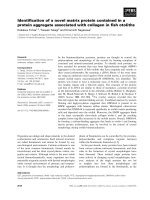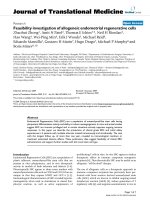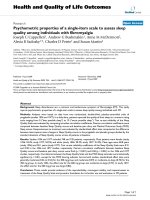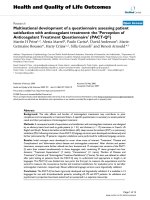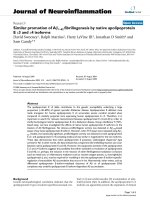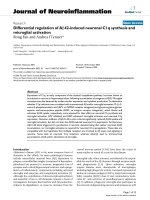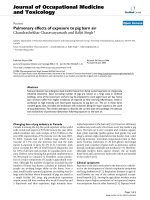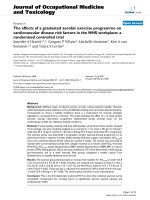báo cáo hóa học:" Biomechanical investigation of a novel ratcheting arthrodesis nail" ppt
Bạn đang xem bản rút gọn của tài liệu. Xem và tải ngay bản đầy đủ của tài liệu tại đây (1.04 MB, 6 trang )
RESEARC H ARTIC L E Open Access
Biomechanical investigation of a novel ratcheting
arthrodesis nail
Jeremy J McCormick
1
, Xinning Li
1*
, Douglas R Weiss
1
, Kristen L Billiar
2
, John J Wixted
3
Abstract
Background: Knee or tibiotalocalcaneal arthrodesis is a salvage procedure, often with unacceptable rates of
nonunion. Basic science of fracture healing suggests that compression across a fusion site may decrease nonunion.
A novel ratcheting arthrodesis nail designed to improve dynamic compression is mechanically tested in
comparison to existing nails.
Methods: A novel ratcheting nail was designed and mechanically tested in comparison to a solid nail and a
threaded nail using sawbones models (Pacific Research Laboratories, Inc.). Intramedullary nails (IM) were implanted
with a load cell (Futek LTH 500) between fusion surfaces. Constructs were then placed into a servo-hydraulic test
frame (Model 858 Mini-bionix, MTS Systems) for application of 3 mm and 6 mm dynam ic axial displacement
(n = 3/group). Load to failure was also measured.
Results: Mean percent of initial load after 3-mm and 6-mm displacement was 190.4% and 186.0% for the solid nail,
80.7% and 63.0% for the threaded nail, and 286.4% and 829.0% for the ratcheting nail, respectively. Stress-sh ielding
(as percentage of maximum load per test) after 3-mm and 6-mm displacement averaged 34.8% and 28.7% (solid
nail), 40.3% and 40.9% (threaded nail), and 18.5% and 11.5% (ratcheting nail), respectively. In the 6-mm trials,
statistically significant increase in initial load and decrease in stress-shielding for the ratcheting vs. solid nail
(p = 0.029, p = 0.001) and vs. threaded nail (p = 0.012, p = 0.002) was observed. Load to failure for the ratcheting
nail; 599.0 lbs, threaded nail; 508.8 lbs, and solid nail; 688.1 lbs.
Conclusion: With significantly increase of compressive load while decreasing stress-shielding at 6-mm of dynamic
displacement, the ratcheting mechanism in IM nails may clinically improve rates of fusion.
Background
Intramedullary (IM) implants are used clinically to pro-
vide stability and expedite fracture healing and fusion
[1-5]. IM devices may be utilized to facilitate femoral-
tibial (knee) [3,5-9] or tibio-talo-calcaneal (TTC) fusion
[4,10,11]. Knee fusion is most commonly performed for
failed total knee arthroplasty secondary t o multiple
infections or severe post trau matic arthritis [1,5,9,12].
TTC fusion is a salvage procedure performed in patients
with severe pain and/or deformity as seen in complex
hindfoot fractures or congenital deformities, septic
arthritis, failed total ankle arthroplasty, or neuropathic
(Charcot) a rthropathy [4,11,13]. The goal of fusion sur-
gery is to relieve pain and improve function b y
eliminating motion through solid bony union at the pro-
blem joint [14]. To achieve knee or TTC fusion, techni-
ques such as use of plates, screws, pins, staples, and
external fixation devices have all been described in the
literature [3,14-18].
Seemingly inherent with the complexity of the proce-
dure is a relat ively high rate of complications such as
nonunion, delayed union, sepsis, delayed wound healing,
and adjacent joint arthritis [2,4,9,13]. Cooper cited an
11-40% rate of nonunion in their TTC fusion study
patient s [10]. Knee fusions have achieved better success
than TTC fusion, however, multiple studies still show a
20-30% failure of fusion depending on the technique
that is utilized [7-9,19,20].
With these factors in mind, improving mechanical sta-
bility at the fusion surface to decrease nonunion rates
while minimizing patient morbidity is a difficult endea-
vor. This novel arthrodesis nail with a ratcheting
* Correspondence:
1
Department of Orthopaedic Surgery, University of Massachusetts, Medical
Center, Worcester, Massachusetts 01655, USA
Full list of author information is available at the end of the article
McCormick et al. Journal of Orthopaedic Surgery and Research 2010, 5:74
/>© 2010 McCormick et al; licensee BioMed Central Ltd. This is an Open Access article distri buted under the terms of the Creative
Commons Attribution License ( which permits unrestricted use, distribution, and
reproduction in any medium, provided the original work is properly cited.
mechanism (Figure 1) was designed with the goal to
maintain maximal compression across the joint fusion
surface throughout the healing process, which may theo-
retically improve stability. Our hypothesis is that using a
ratcheting technology in a fusion procedure will maxi-
mize compression forces across the fusion surface with
axial loading. This study investigates the mechanical
properties (axial compression, stress shielding and load
to failure) of this ratcheting nail design relative to the
current designs used in clinical practice (threaded and
solid nails).
Materials and methods
To compare the proper ties of this ratcheting nail to the
mechanical properties of existing designs for fusion
nails, a total of three different IM nails were manufac-
tured. Prototype #1 was a solid nail that is commonly
used in clinical practice. Prototype #2 uses a threaded
interlocking device similartothatusedincurrently
marketed knee fusion nail designs to provide compres-
sion at the time of implantation. Prototype #3 is the
novel IM nail with the ratcheting design (Figure 2).
A knee design sawbone (foam cortical shell bone
model, Pacific Research, Inc) fusion model was used to
test our hypothesis (by utilizing a ratcheting design in a
fusion nail compression forces across the fusion surface
can be maximized with axial loading). The distal femur
and t he proximal tibia were cut in a manner consistent
with standard knee fusion. A femoral and a tibial cutting
jig were created to ensure uniformity of bone resection
and that the surfaces were flush to each other. After
preparation of the fusion surface, the sawbones were
then potted into PVC (polyvinyl chloride) pipe caps
using potting cement (Quick Crete Products, Inc.
Norco, CA 92860) (Figure 3).
The three prototypes were inserted into the fusion
construct in a manner replicating in-vivo surgical tech-
nique. The IM nail was first inserted retrograde into the
femur and stati cal ly locked. Then t he nail was insert ed
into the tibial canal in an antegrade direction.
A washer-type load cell (Futek LTH 500) was used to
separate the fusion surfaces. For the s olid nail, manual
compression was applied with a pointed tenaculum
clamp (an instrument used in the operating room to
assist in fracture reduction) prior to statically locking
the distal aspect of the nail into the tibia with a screw.
With the threaded nail, compression was also applied
with a pointe d tenaculum clamp before locking. Then, a
hexagonal wrench was used to rotate the threaded lock-
ing mechanism to provide further compression. For the
ratcheting nail, after locking the female and male com-
ponents into the femur and tibia, respective ly, the com-
ponents were engaged and maximally ratcheted together
by hand and with a pointed tenaculum clamp.
Mechanical testing was conducted using a Mini-Bionix
858 test frame (MTS, Inc. Eden Prairie, MN 55344).
Load was measured at the site of compression using a
washer-type load cell (Figure 3) with a central hole
rated to 2000 lbs of failure (Futek, Inc. Irvine, CA).
Tests were completed in displacement control mode
(3 mm and 6 mm). Total compressive force, in-joint
comp ressive force, distance, and time at a rate of 1 data
point per 0.25 seconds were all recorded by computer
read-out. The displacement position was held for ten
seconds and the load was then removed from the sys-
tem. Each prototype nail was tested in three sawbone
knee constructs and data was collected for each test
run. The resultant load across the fusion surface at the
completion of each test cycle (as recorded by the load
cell) was measured. This data point was then compared
Figure 1 The ratchet design of the novel arthrodesis nail. Both pre-compression and post-compression teeth interlocking are demonstrated.
Axial loading will result in nail shortening and dynamic compression at the site of fusion.
McCormick et al. Journal of Orthopaedic Surgery and Research 2010, 5:74
/>Page 2 of 6
to the load reflected across the load c ell after manual
compression (initial load) to determine the percent of
initial load across the fusion site. The average percent of
initial load was then calculated for each of the three nail
designs (Table 1) and standard deviation was also
calculated.
Stress shielding data were also calculated by recording
the maximum load applied to the system by the test
frame and comparing it to the load cell me asurement of
compression at that maximum external force. This value
was recorded as percentage of the maximum load not
reflected at the fusion surface (Table 2). A lower percen-
tage thus reflects less stress shielding. All results were
analyzed statistically using the Student t-test with signif-
icance set at p < 0.05.
Load of failure were conducted with a mechanical test
frame in axial compressi on (Admet Model 2611, Expert
load frame, Norwood, MA) under load control u sing
specimens gapped to a fixed distance. Load versus dis-
placement curves were generated for each of the proto-
type nail. Nails were tested at 10 lbs/second to a
maximum displacement of 1 cm. To account for the
thread screw and ratcheting mechanism in prototype 2
and 3, we tightened the screw mechanism maximally
and comp ressed the ratchet to its maximal point before
application o f load. For the purpose of this t est, load of
failure was defined as displacement of greater than 1 cm
or an abrupt drop in the load displacement curve indi-
cating the nails inability to transmit load.
Results
Thesolidandthreadednailsdidnothavelarge
increases in initial compression load across the fusion
surface after the 3 mm and 6 mm displacement trials.
However, the ratcheting nail did have a significant
increase in initial compression, especially at 6 mm of
displacement. In the 3 mm displacement trials, we
found no significant difference in maintenance of initial
load for the solid vs. ratcheting nail (p = 0.70) or the
threaded vs. ratcheting nail (p =0.40).Dataforthe6
mm displacement trials, however, showed a significant
increase in the initial compressive load maintained
acr oss the fusion surface with the ratcheting nail versus
the solid na il (829.8% vs. 186.8%, p = 0.03) an d versus
the threaded nail (829.8% vs. 63.0%, p = 0.01).
The stress shielding result s of the solid and threaded
nails were compared to the ratcheting nail. No statisti-
cally significant difference was found when comparing
stress-shielding for the 3 mm displacement t rials
between the ratchet ing vs. s olid nail (p =0.12)orthe
ratcheting vs. threaded nail (p =0.11).Forthe6mm
displacement trials, however, there was a significant
decrease in stress-shielding through the system when
the ratcheting nail was compared to the solid nail
(11.5% vs. 28.7%, p = 0.001) and the threaded nail
(11.5% vs. 40.9%, p = 0.002).
Load to failure in axial compression for the ratchetin g
nail was 599.0 lbs, threaded nail was 508.8 lbs, and solid
nail at 688.1 lbs. In each ca se, the specimens failed at
the interlocking screws (Figure 4).
Discussion
The goal of joint arthrodesis is to create a painless and
stable union between the intended fusion surfaces as a
means to improve a patient’ sfunctionandoutcome
[2,3,21]. When fusion is not achieved (non-union), pain
Figure 2 Ratcheted nail, threaded nail and solid nail is shown in the photograph. The ratcheting nail provides dynamic compression with
axial loading while the threaded nail allows manual compression with each turn of the thread. The solid nail does not allow any type of
compression across the fusion site.
McCormick et al. Journal of Orthopaedic Surgery and Research 2010, 5:74
/>Page 3 of 6
and disability commonly persist. Knee arthrodesis has
been performed since the 1900s to treat conditions asso-
ciated with arthritis, sepsis, Charcot neuropathy, and
reconstruction following tumor resection [3,21]. With
the success of modern total knee arthroplasty (TKA),
the current indication fo r knee arthrodesis have been
narrowed to primarily include patients who have failed
TKA with sepsis, significant bone loss, or instability in
an unreconstructable knee [1,3,5-9,12,16,20,21]. The
fusion rate following knee arthrodesis is significantly
higher for patients with post traumatic or rheumatoid
arthritis [22,23] (>95%) in comparison to patients with
the diagnosis of charcot arthropathy or infection after
TKA [2,3,6,7,9,16,24] (30% to 100%). Tibiotalar Calca-
neal (TCC) fusion is a salvage procedure used to treat
failed total ankle arthroplasty, sepsis, po st traumatic
arthritis, or hindfoot deformities [4,6,10,11]. Up t o 50%
complication rate have been reported in the literature
with TCC fusion that include infection, nonunion, malu-
nion, wound complications, and amputation [10].
Figure 3 Test construct loaded in MTS machine with the
sawbone potted in cement with PVC pipes at both the
proximal femur and distal tibia. After insertion of the nail (solid,
threaded or ratcheting) a load cell was placed flush to the fusion
surface for the mechanical testing.
Table 1 Data for percent initial load of each test
construct
% initial load 3 mm % initial load 6 mm
Solid 1 96 75.9
Solid 2 103.3 132.6
Solid 3 372 352
Solid Avg. 190.4 186.8
Solid S.D. 140.7 130.4
Threaded 1 72.8 50.6
Threaded 2 80.9 62.8
Threaded 3 88.3 75.5
Threaded Avg. 80.7 63.0
Threaded S.D. 6.9 11.1
Ratcheting 1 42.5 855
Ratcheting 2 99.4 517.1
Ratcheting 3 717.39 1117.4
Ratcheting Avg 286.4 829.8
Ratcheting S.D. 329.0 269.1
Table 2 Data for stress shielding (SS) expressed as
percent of initial load not reflected at fusion surface
SS 3 mm SS 6 mm
Solid 1 33.0 32.0
Solid 2 41.0 28.6
Solid 3 30.4 25.4
Solid Avg. 34.8 28.7
Solid S.D. 4.9 3.0
Threaded 1 54.5 48.6
Threaded 2 29.1 33.7
Threaded 3 37.2 40.5
Threaded Avg. 40.3 40.9
Threaded S.D. 11.6 6.7
Ratcheting 1 29.0 11.5
Ratcheting 2 22.6 12.2
Ratcheting 3 3.8 10.7
Ratcheting Avg 18.5 11.5
Ratcheting S.D. 11.7 11.5
McCormick et al. Journal of Orthopaedic Surgery and Research 2010, 5:74
/>Page 4 of 6
Therefore it is essential to improve the current design of
fusion nails to maximize the stability of the fusion sur-
face to improve clinical healing.
This investigation was performed with the goal of
improving the currently commercially available fusion
nails by utilizing a novel ratcheting device that could be
used to allow dynamic loading across an intended site of
joint fusion. The data demonstrated a statistically signifi-
cant improvement in initial load across the fusion sur-
face with the ratcheting nail (Prototype #3) when
compared to the solid and threaded nails in the 6-mm
displacement load trials. As the teeth in the ratcheting
device engaged, the amount of compression applied was
maintained and would allow increased compression
forces across the fusion site. When compression displa-
cement of only three millimeters was applied, an advan-
tage was not seen with the ratcheting device. This
finding was primarily because the amount of compres-
sion was insufficient to advance the ratchet mecha nism.
However, analysis of the 3-mm displacement data points
for the ratcheting nail (Table 1) demonstrates an aber-
rantly high value for one trial (Ratcheting #3). In this
particular trial, the te eth of the ratchet mechanism were
able to advance with only 3-mm of displacement. The
teeth of this ratcheting nail can be engineered to be at
variable length that would allow for controlled displac e-
ment with axial loading.
There is a distinct advantage in the ratcheting
mechanism when compared to the currently clinically
available nails. With sufficient axial load, the ratchet will
advance. Therefore, it will always maintain a significant
amount of compress ive force at the fusion surf ace, even
with subsidence or collapse of bone at the fusion surface
over time. Dynamization or axial compression of trans-
verse osteotomies has been shown to increase both the
torsional stability and maximal torque of the fracture
site when compared to locked rigid control in a canine
model [25]. Both the solid and threaded nail design will
not allow further advancement of the nail with axial
loading as they are both statically locked devices.
Furthermore, the stress shielding data for the 6-mm dis-
placement trials demonstrated a significant (p <0.05)
decrease in stress shielding for the ratcheting nail as
comp ared to both the solid and the threaded nails. This
decrease in stress shielding is likely a result of the
dynamic nature of the ratcheting design which allows
for controlled axial compression at the fusion surface.
The solid and the threaded nail designs, by comparison,
were statically locked and thus provided a greater degree
of stress shielding. This decrease in stress shielding may
also be an advantage for improved bo ne healing and
fusion [26,27].
To further investigate the mechanical properties of the
ratcheting nail, we tested the three prototypes to failure
in axial compression. We chose to test them in com-
pression because this is the likely mode of primary load-
ing. However, this may not represent true physiologic
loads as the nails placed clinically would likely be sub-
jected to both torsional and moment loads as well as
pure axial loading. For the purpose of this test, load of
failure was defined as displacement of greater than 1 cm
or an abrupt drop in the load displacement curve indi-
cating the nails inability to transmit load. In each case,
the specimens failed at the interlocking screws. This is
not surprising as in clinical situations; locking screw fail-
ure is the most comm only seen mode of failure after
long bone nonunion or fracture [28]. However, each
specimen was able to withstand axial loads of greater
than500lbspriortofailure.Whilethistestdoesnot
address potential weakness of the ratcheting nail after
cyclic loading, it does confirm that the bone-implant
interface is the weakest aspect of t he construct as evi-
denced by failure of the locking screw.
The major limitation of this study is that this is an in
vitro biomechanical analysis characterizing only the
axial compression, stress shielding, and load to failure of
this novel ratcheting fusion nail. Evaluating the axial
compressive properties without testing torsion and
bending is not sufficient to fully evaluate a fusion
Figure 4 Failure of the distal interlocking screw at the tibia
observed with axial load. This is the primary mode of failure in all
tested constructs.
McCormick et al. Journal of Orthopaedic Surgery and Research 2010, 5:74
/>Page 5 of 6
fixation nail. In the clinical setting , there are more
forces involved at the fusionsiteandwithoutfurther
mechanical testing of this nail, clinical trials can not be
performed. We believe that by increasing the compres-
sion forces across the fusion surface with axial loading
while minimizing stress shielding will increase clinical
rates of knee or TCC fusion, however, this statement
along with characte rizing the torsion and bending prop-
erties of this nail needs to be further investigated.
Conclusion
This data, while preliminary, suggests that a ratcheting
device may have useful clinical applications. A statisti-
cally significant inc rease in the load maintained across
the fusion surface and decrease in the stress shielding of
the fusion construct with a ratcheting nail was seen
with 6 mm of displacement. The preliminary data from
this study validates the concept that a ratchet mechan-
ism may be a viable design option for a fusion nail to
maximize compression and facilitate union. However,
further experiments in the future will be performed in
cadaver models to further characterize the mechanical
properties (torsion and bending) of this ratcheting nail
before clinical experimentations.
Acknowledgements
Provided internally by the University of Massachusetts Medical Center
through a Commercial Ventures and Intellectual Property Grant.
Author details
1
Department of Orthopaedic Surgery, University of Massachusetts, Medical
Center, Worcester, Massachusetts 01655, USA.
2
Biomedical Engineering
Worcester Polytechnical Institute Worcester, Massachusetts 01655. USA.
3
Department of Orthopaedic Surgery, University of Massachusetts, 55 Lake
Avenue North, Worcester, Massachusetts 01655, USA.
Authors’ contributions
XL, JM and JW have contributed to the data collection/interpretation,
mechanical testing and drafting/revising of the manuscript. DW and KB have
contributed to the mechanical testing and mechanical evaluation of the
fusion nails. JW have contributed to the conception and design of this
particular ratcheting arthrodesis nail. All authors approved the final
manuscript.
Competing interests
The authors declare that they have no competing interests.
Received: 5 February 2010 Accepted: 14 October 2010
Published: 14 October 2010
References
1. Broderson MP, Fitzgerald RH, Peterson LF, Coventry MB, Bryan RS:
Arthodesis of the knee following failed total knee arthroplasty. Journal of
Bone and Joint Surgery American 1979, 61A:181-85.
2. Frey C, Halikus NM: A Review of Ankle Arthrodesis: Predisposing Factors
to Nonunion. Foot and Ankle International 1994, 15:581-84.
3. MacDonald JH, Agarwal S, Lorei MP, Johanson NA, Freiberg AA: Knee
Arthrodesis. Journal of American Academy of Orthopaedic Surgeons 2006,
14:154-63.
4. Millett PJ, O’Malley MJ, Tolo ET, Gallina J, Fealy S, Helfet DL:
Tibiotalocalcaneal fusion with a retrograde intramedullary nail: clinical
and functional outcomes. American Journal of Orthopaedics 2002, 31:531-6.
5. Incavo SJ, Lilly JW, Bartlett C, Churchill DL: Arthrodesis of the knee:
experience with intramedullary nailing. Journal of Arthroplasty 2000,
15:871-6.
6. Crockarell JR, MJ M: Knee Arthrodesis using an intramedullary nail.
Journal of Arthroplasty 2005, 20:703-8.
7. Figgie HE, Brody GA, Inglis AE, Sculco TP, Goldberg VM, Figgie MP: Knee
arthrodesis following total knee arthroplasty in rheumatoid arthritis.
Clinical Orthopaedics 1987, 224:237-43.
8. Hagemann WF, Woods GW, Tullos HS: Arthrodesis in failed total knee
replacement. Journal of Bone and Joint Surgery American 1978, 60:790-94.
9. Talmo CT, Bono JV, Figgie MP, Sculco TP, Laskin RS, Windsor RE:
Intramedullary Arthrodesis of the knee in the treatment of sepsis after
TKR. HSS Journal 2007, 3:83-88.
10. Cooper PS: Complications of Ankle and Tibiotalocalcaneal Arthrodesis.
Clinical Orthopaedics 2001, 391:33-44.
11. Russotti GM, Johnson KA, Cass JR: Tibiotalocalcaneal Arthrodesis for
Arthritis and Deformity of the Hind Part of the Foot. Journal of Bone and
Joint Surgery American 1988, 70A:1304-07.
12. Rand JA, Bryan RS: The outcome of failed knee arthrodesis following total
knee arthroplasty. Clinical Orthopaedics 1986, 205:86-92.
13. Berson L, McGarvey WC, Clanton TO: Evaluation of Compression in
Intramedullary Hindfoot Arthrodesis. Foot and Ankle International 2002,
23:992-95.
14. Berend GM, Glisson RR, Nunley JA: A Biomechanical Comparison of
Intramedullary Nail and Crossed Lag Screw Fixation for
Tibiotalocalcaneal Arthrodesis. Foot and Ankle International 1997,
18:639-43.
15. Rochwerger A, Parratte S, Sbihi A, Roge F, Curvale G: Knee arthrodesis with
two monolateral external fixators: 19 cases with a mean follow up of 7
years. Journal of Bone and Joint Surgery British 2005, 88B:82-5.
16. Prichett JW, Mallin BA, Matthews AC: Knee Arthrodesis with a tension-
band plate. Journal of Bone and Joint Surgery American 1988, 70:285-88.
17. Spina M, Gualdrini G, Fosco M, Giunti A: Knee arthrodesis with the Ilizarov
external fixator as treatment for septic failure of knee arthroplasty.
Journal of Orthopedic traumatology 2010, 11:81-88.
18. Kuo AC, Meehan JP, Lee M: Knee fusion using dual plating with the
locking compression plate. Journal of Arthroplasty 2005, 20:772-6.
19. Hak DJ, Lieberman JR, Finerman GAM: Single plane and biplane external
fixators for knee arthrodesis. Clinical Orthopaedics 1995, 316:134-44.
20. Knutson K, Lindstrand A, Lidgren L: Arthrodesis after failed knee
arthroplasty: A nationwide multicenter investigation of 91 cases. Clinical
Orthopaedics 1984, 191:202-11.
21. Conway JD, Mont MA, Bezwada HP: Arthrodesis of the knee. Journal of
Bone and Joint Surgery American 2004, 86:835-48.
22. Charnley J: Arthrodesis of the knee. Clinical Orthopaedics 1960, 18:37-42.
23. Charnley J, Lowe HG: A study of the end results of compression
arthrodesis of the knee. Journal of Bone and Joint Surgery British 1958,
40:633-5.
24. Damron TA, McBeath AA: Arthrodesis following failed total knee
arthroplasty: Comprehensive review and meta-analysis of recent
literature. Orthopedics 1995, 18:361-8.
25. Egger EL, Gottsauner-Wolf F, Palmer J, Aro H, Chao EYS: Effects of axial
dynamization on bone healing. Journal of Trauma-injury Infection & Critical
Care 1993, 34:185-91.
26. Gefen A: Optimizing the biomechanical compatibility of orthopedic
screws for bone fracture fixation. Med Eng Phys 2001, 24:337-47.
27. Liu JG, Xu XX: Stress shielding and fracture healing. Zhonghua Yi Xue Za
Zhi 1994, 74:483-5.
28. Ito K, Hungerbuhler R, Wahl D, Grass R: Improved intramedullary nail
interlocking in osteoporotic bone. Journal of Orthopedic Trauma 2001,
15:192-6.
doi:10.1186/1749-799X-5-74
Cite this article as: McCormick et al.: Biomechanical investigation of a
novel ratcheting arthrodesis nail. Journal of Orthopaedic Surgery and
Research 2010 5:74.
McCormick et al. Journal of Orthopaedic Surgery and Research 2010, 5:74
/>Page 6 of 6
